Geoff Nicholson's Blog, page 61
April 24, 2012
THE DIRTY BOULEVARD
[image error]
Being a pedestrian of international stature (he says self-mockingly), once in a while I do get photographed by some really good photographers. The latest is David Westphal who just photographed me for the JWM magazine, the in house mag of the Marriott Hotel group, so my image will be an adornment to hotel rooms the world over for three months or so, which would appeal to anybody’s vanity.
But of course vanity means that you actually worry about looking good. That being the case, I’m always a willing model if not a very natural or comfortable one. In general it’s easier when I’m doing something, and since walking is one of the things I apparently to do best, it made sense to take some pics of me in mid-stride.
David asked if I knew a good location where I might walk and where he might do the shoot. I suggested Griffith Park, up by the batcave, with the possibility of a view of the Hollywood sign in the background. Cheesy but effective. And one of the great attractions from my point of view was that on a weekday afternoon I reckoned there wouldn’t be many people around, so the potential for embarrassment and self-consciousness would be much reduced. David said that sounded great, but you know, somehow I didn’t really think it would be that simple.
Come the day of the shoot David had had a better idea. He thought it would be really great if we took some pictures slap bang in the middle of Hollywood Boulevard, sometimes with me walking, sometimes with me standing still as pedestrians swarmed around me. Now I dare say Naomi Campbell would have stamped her little foot and refused, but I am no Naomi Campbell, and frankly this sounded like a much better idea for a picture, so I went with it. I’m not sure I really had a choice.
And rather a peculiar thing happened. I’m not saying I look especially at ease in the pictures, but in the event I felt remarkably unembarrassed and unselfconscious during the shoot. I guess it has something to do with the nature of Hollywood Boulevard. First of all, whatever you’re doing there, however odd, there are always going to be plenty of people doing much odder things: a man dressed in a SpongeBob SquarePants costume, some guy forcing his CD into the hands of unwilling tourists “Well you gotta take it now ‘cause I’ve signed it for ya,” a male/female busking duo who seemed to be making up their songs as they went along, at one point launching into the lyrics, “Lick, lick that jellybean, lick it lick it till I scream.” The chaos was oddly liberating.
As of now I’m not sure which shot the magazine has chosen (and no I don’t have image approval), but I think it probably isn’t the one at the top of this post, which is a shame. You might argue that this isn’t really a picture of me walking, but it’s the one I like best. It has so much going for it: a tyrannosaurus, a bunch of overdressed hipsters, and the author, staring into distance, not exactly relaxed, and by no means above it all, but detached and aware and observant. That sounds like me.
David Westphal’s website is here:http://www.westphalphotography.com/


Being a pedestrian of international stature (he says self-mockingly), once in a while I do get photographed by some really good photographers. The latest is David Westphal who just photographed me for the JWM magazine, the in house mag of the Marriott Hotel group, so my image will be an adornment to hotel rooms the world over for three months or so, which would appeal to anybody’s vanity.
But of course vanity means that you actually worry about looking good. That being the case, I’m always a willing model if not a very natural or comfortable one. In general it’s easier when I’m doing something, and since walking is one of the things I apparently to do best, it made sense to take some pics of me in mid-stride.
David asked if I knew a good location where I might walk and where he might do the shoot. I suggested Griffith Park, up by the batcave, with the possibility of a view of the Hollywood sign in the background. Cheesy but effective. And one of the great attractions from my point of view was that on a weekday afternoon I reckoned there wouldn’t be many people around, so the potential for embarrassment and self-consciousness would be much reduced. David said that sounded great, but you know, somehow I didn’t really think it would be that simple.
Come the day of the shoot David had had a better idea. He thought it would be really great if we took some pictures slap bang in the middle of Hollywood Boulevard, sometimes with me walking, sometimes with me standing still as pedestrians swarmed around me. Now I dare say Naomi Campbell would have stamped her little foot and refused, but I am no Naomi Campbell, and frankly this sounded like a much better idea for a picture, so I went with it. I’m not sure I really had a choice.
And rather a peculiar thing happened. I’m not saying I look especially at ease in the pictures, but in the event I felt remarkably unembarrassed and unselfconscious during the shoot. I guess it has something to do with the nature of Hollywood Boulevard. First of all, whatever you’re doing there, however odd, there are always going to be plenty of people doing much odder things: a man dressed in a SpongeBob SquarePants costume, some guy forcing his CD into the hands of unwilling tourists “Well you gotta take it now ‘cause I’ve signed it for ya,” a male/female busking duo who seemed to be making up their songs as they went along, at one point launching into the lyrics, “Lick, lick that jellybean, lick it lick it till I scream.” The chaos was oddly liberating.
As of now I’m not sure which shot the magazine has chosen (and no I don’t have image approval), but I think it probably isn’t the one at the top of this post, which is a shame. You might argue that this isn’t really a picture of me walking, but it’s the one I like best. It has so much going for it: a tyrannosaurus, a bunch of overdressed hipsters, and the author, staring into distance, not exactly relaxed, and by no means above it all, but detached and aware and observant. That sounds like me.
David Westphal’s website is here:http://www.westphalphotography.com/

Published on April 24, 2012 18:42
April 12, 2012
FOSTERING THE CITY
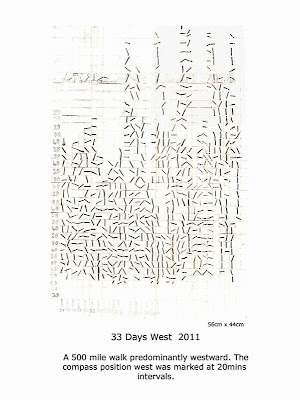
I just got an email from a satisfied customer who'd read The Lost Art of Walking, "had a good time with it" and thought I might be interested in her artwork. She wasn't wrong. That's it above and below. Her name is Foster Spragge, which sounds somehow like an anagram, and indeed is an anagram for a great many things including "far gorge steps," which isn't entirely inappropriate.

One of her projects is to make "Walking Drawings" that record the walks she's done, and I'm always fascinated by the question of how we want to remember or memorialize our walking. I know there are some walkers who don't want any sort of record, but I think the majority do, whether it's just making notes, or taking pictures, or marking it on a map, or in extreme cases writing books and blogs. Of course there are myriad other ways too.

Foster Spragge writes on her blog, "Whilst searching for a venue for the installation of Ticket Cylinder (that's one of her 'sculptural' artworks) I began to Walk & Draw. Mirroring the walking process, tracing a movement while allowing the mind to roam exploring new thoughts. To start each Drawing, the paper is folded so that only part of it can be seen at any one time while working. This stops aesthetic decisions, allowing the drawing to take its own shape. The whole Drawing is not unfolded until the walk is finished. The initial Drawings are filled with an explorative range of marks to represent footsteps. For every step during the walk a pencil mark is made. Each time the path turns the paper is turned the same way."
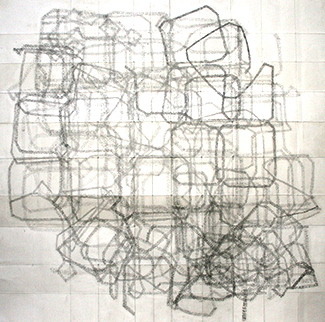
Well this all seemed pleasantly obsessive, especially the part about making one mark for each footstep. It also wasn't clear to me just how big these pieces of folded paper were. I imagined she might be strolling around with a piece of paper six feet square. I wanted too much – they're just 59 centimeters square.
Even so, as she explained in an email, "Walking though town folding and unfolding is a challenge. What is quite amusing is people often ask me for directions." Then when she was doing the Square Mile Walks, a series of drawings made while walking within the square mile of the City of London, never venturing outside the city boundary, "some bikers spied me walking around the edge of Smithfields market while avoiding the rain. They asked me what I was doing, on showing them the Drawing they said I should buy myself a map."
Well, this is interesting isn't it? Obviously some of these drawings don't resemble maps in any conventional way, but some definitely do.
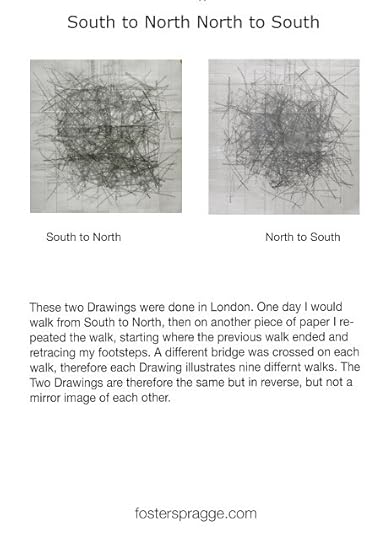
Above are two drawings, a diptych I suppose, titled South to North, North to South. They record a series of London walks. In case the caption comes out too small on the blog, I'll repeat what Foster writes, "One day I would walk from South to North, then on another piece of paper I repeated the walk, starting where the previous walk ended and retracing my footsteps … The two drawings are therefore the same but in reverse, but not a mirror image of each other." You can never walk in the same street twice.
Now obviously you'd be hard pressed to find your way around London with these drawings, but when you look at them you somehow know that they represent a walk in London. A walk made in Manhattan or Paris or Colchester simply wouldn't look like that.
These days we all feel that maps printed, or drawn, on paper are a dying form, as GPS and cell phone technology takes over. At the same time, if you're lost in a big city and you see someone carrying a map (or in this case what only appears to be a map) you're far more likely to approach them for directions than you are to approach someone who's simply carrying a cell phone.
Foster Spragge's drawings are on show for a short time at the Westminster Reference Library in London, behind the National Gallery, Orange Street, 28th May to 2nd June.
Her website is here: http://www.fosterspragge.com/
It so happens that I too sometimes walk around Smithfield market, though in a rather less rigorous way that Foster Spragge, and I've never been troubled by bikers. Here's a picture I took on one of my walks there, a much-photographed tripe dresser wedged between a classical column and a men's lavatory. Ah, London.
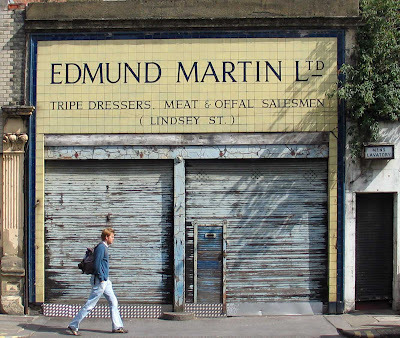

Published on April 12, 2012 14:25
April 11, 2012
AND SPEAKING OF FRANK LLOYD WRIGHT
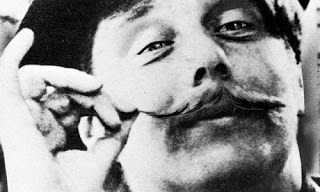
Regular readers will remember the entry a few weeks back about HG Wells saying, "I write as I walk because I want to get somewhere and I write as straight as I can, just as I walk as straight as I can, because that is the best way to get there."
Well, life being like that, I just came across an anecdote about Frank Lloyd Wright, which suggests he took a very different view. That's a picture of him below, with his wife Oglivanna, walking along the esplanade at Florida Southern College.
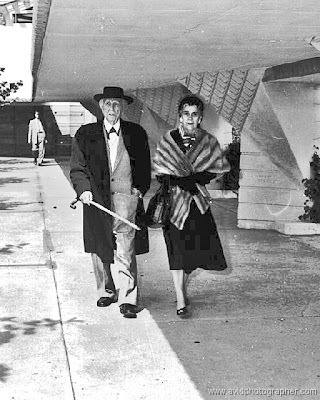
He was nine years old, there was snow on the ground, and he went walking with a no-nonsense uncle. After they'd crossed a snow-covered field the uncle stopped and looked back at their footsteps. Then the uncle said, "Notice how your tracks wander aimlessly from the fence to the cattle to the woods and back again. And see how my tracks aim directly to my goal. There is an important lesson in that."
Wright reckoned there was a quite different lesson from the one his uncle intended, one that changed his outlook on life. "I determined right then, not to miss most things in life, as my uncle had."
I think Wright never walked around the finished Ennis House – he fell out with his clients and his son took over. There's evidence however of some quite spectacular walking around the place, organized by Helmut Newton.
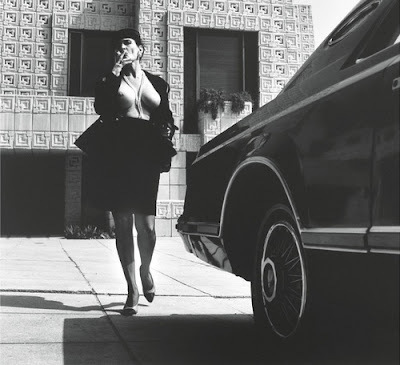

Published on April 11, 2012 10:47
April 7, 2012
KING OF THE CASTLE, TOP OF THE HILL
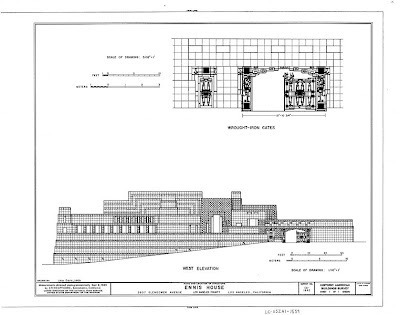
On Sunday afternoon the Loved One and I walked over to stare at the outside of Frank Lloyd Wright's Ennis House, the one that used to be know as the Ennis-Brown House, the one that looks like a Mayan temple, or (depending on its state or repair, which fluctuates alarmingly) like Mayan ruins. Lord knows how many millions of dollars have been spent on restoring it, and it still looks a bit crumbly at the edges, (not that there's anything wrong with that), but it's certainly been much, much worse.

To get there we walked along Los Feliz Boulevard, and boy, the street was full of Sunday afternoon walkers, couples, singles families, some with dogs, some with strollers, various ages and ethnicities. Heck, it felt like a real boulevard, a real promenade, although of course it lacked the charming cafes and bars that would have been on a French boulevard, and it lacked the fish and chips and "kiss me quick" hats there'd have been on an English promenade, but for supposedly pedestrian-hostile Los Angeles, it looked pretty friendly.
I'd printed off a yahoo map showing me the route to the Ennis House, but I got confused and I misread it. We should have walked up the Berendo Street Stairs, but like a fool I missed them, and I took us up the steep curves of Glendower Avenue instead. It was no problem but I'd have preferred to use the stairs.
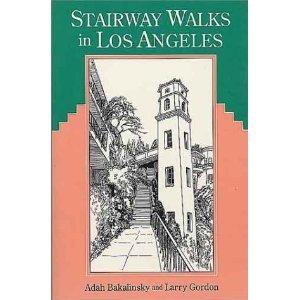
There is something great about LA's flights of stairs, they're not like stairs anywhere else. And when I first moved here I bought the book Stairway Walks in Los Angeles by Adah Bakalinsky and Larry Gordon, not least because I lived at the top of a flight of stairs in Silver Lake. I used the book to do a few of the walks in that neighborhood, including the Vendome Steps, which are the ones Laurel and Hardy have such trouble with in the movie The Music Box.
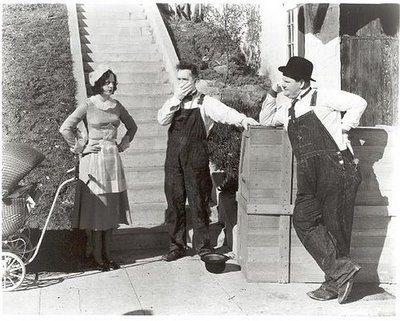
And I did the stairs of Whitley Heights and some in Castlemmarre (below), which were fictionalized by Raymond Chandler in Farewell My Lovely.
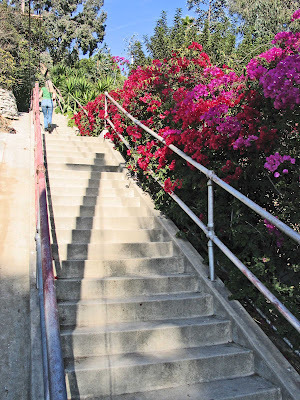
In the introduction to the book the authors say, "Los Angeles has more than 200 stairways; they qualify Los Angeles as a walking city." Well, as Ernst Hemingway might say, "Isn't it pretty to think so?" The authors also describe the Ennis Brown house as being made of "cinder blocks of grayish color." Frank Lloyd Wright, and his fans (and I'm one of them) would much prefer the term "textile block," and I think in general they're more sand-colored, though admittedly some of the more beat-up ones do have a grubby tinge.
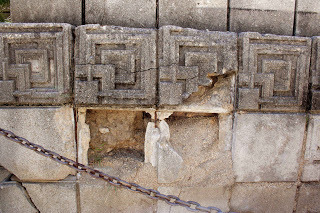
One of the great features of the walk is that right before you get to the Ennis you pass a fairy tale house, complete with a witch for a weather vane.

You walk a little further and you see the Ennis House rising above and behind the curvy, gingerbread tile roof: a couple of competing Hollywood fairy tales.

So we went and looked at the house, walked around it, took a few photographs, wondered if the restoration would ever be finished and what "finished" even meant in this context. There were some lights on inside, but the place didn't look inhabited and we wondered if it was even habitable, and it certainly it was hard to imagine how anyone ever would or could ever live comfortably there.
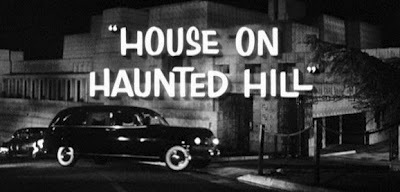
As is the way of these things, the incidentals were at least as enjoyable as journey's end. We came across an extraordinary tree, much of it leaning out across the sidewalk, evidently leaning too far, and so somebody had put a metal strut under the main bough to keep it up, but then the weight of the tree had bent the strut and so they'd added another.
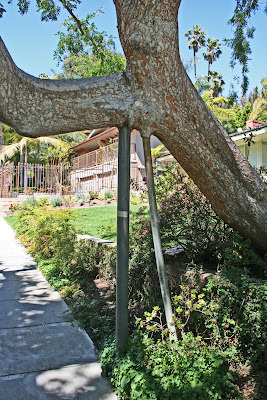
But then the struts had penetrated the branch itself, which had continued to grow around them, so that the ends were now incorporated into the wood. The Loved One, who has a mind like a sewer, decided to call it "the DP tree."
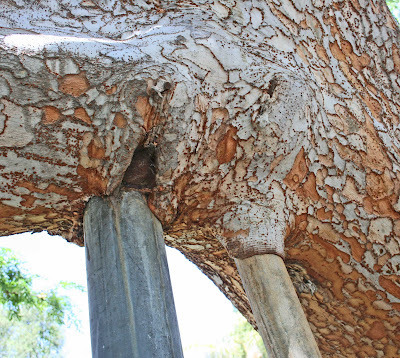
There was also this plane-shaped weather vane which made a nice contrast with the witch version. Small pleasures to be sure, but any pleasure is worth holding on to.

On the way back we walked past the top of St Michael's Stairs (discussed elsewhere in this blog) and passed a young woman walking by herself, holding a copy of a guide book – not the same staircase book that I have, but the other one, Secret Stairs by Charles Fleming. Who'd have thought there'd be two? We exchanged a few words with the girl about the joy of staircases, L.A. and pedestrianism. We Hollywood walkers like to do that kind of thing.
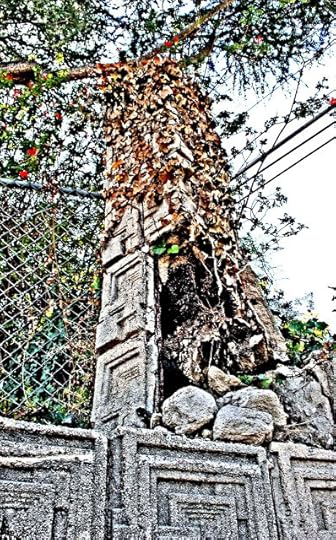

Published on April 07, 2012 08:01
March 29, 2012
YOUR NAME HERE
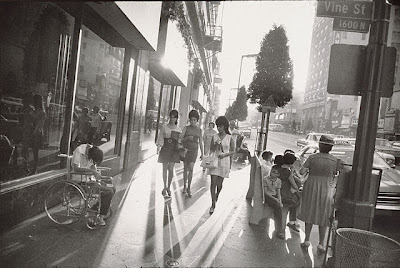 GarryWinogrand, Hollywood Boulevard, 1969, Estate of Garry Winogrand
GarryWinogrand, Hollywood Boulevard, 1969, Estate of Garry WinograndSometimes I wonder what visitors from the future, or possibly from another planet, who arrived in a ruined Hollywood would make of the stars, names, and metallic symbols set in concrete in the sidewalks along the Hollywood Walk of Fame? It think it's fair to imagine that these visitors wouldn't recognize the names in the stars: some of them are unknown to all but the most dedicated film buff even now. But assuming they did recognize them as the names of the people, would they think these slabs were memorials to our heroes and heroines?
Or might they think the opposite, that these were the people we held in special contempt, so much so that we walked on their very names, spat on them, spilled food on them, let our dogs (and occasionally our citizens) urinate all over them? Is it even possible that they'd think these sidewalk slabs were actually gravestones; that James Brown, Myrna Loy, Matt Groening et al were actually buried under the sidewalk? Actually that idea wouldn't last very long at all. Some of these "gravestones" are already in a state of considerable ruin. You can see there's no grave, no body under there.
I walk along Hollywood and Vine fairly often, and usually I don't even see the Walk of Fame stars anymore, but just lately I've been noticing what bad shape some of the slabs are in. I was there a couple of days ago and decided to take note. Many had gouges, stains and scratches, of course, and there was the odd one with a missing letter or two.

Tallulah Bankhead was looking a bit rough around the edges, but certainly she was holding up better than Ava Gardner who had a large crack across her middle, and it looked as though there had been some ham-fisted attempts at restoring her.

Michael Langdon seemed to be just falling apart:

And Elliott Dexter was looking even worse, though I admit I had no idea who Elliott Dexter was till I got home and looked him up: silent movie actor, star of The Squaw Man and Flaming Youth, made his last movie in 1925.

But worst of all, so much the worst, right at the southern end of the Walk, where Vine Street meets Sunset Boulevard, there was this melancholy item:
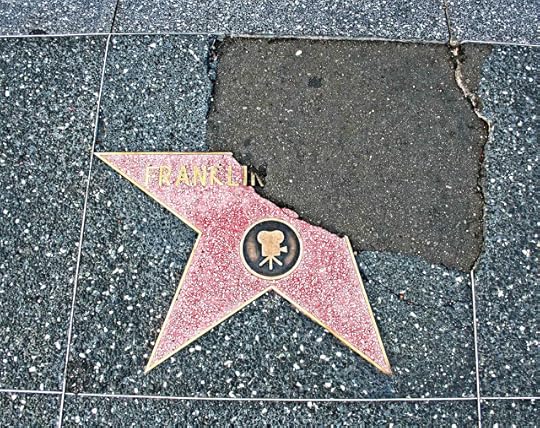
You can just about read the first half of his name "Franklin," and the rest has been removed and replaced by a dollop of tarmac. A little further research reveals that this is the star of Franklin Pangborn, a successful comedy character actor in his day, who appeared with WC Fields in Never Give a Sucker an Even Break which I know I've seen, though not recently, and also, satisfyingly, he appeared in the movie Hollywood and Vine, directed by Alexis Thurn-Taxis (it's about a dog who becomes a star). I'd say Franklin Pangborn deserved better. I'd say just about anybody deserves better.

Published on March 29, 2012 15:25
March 27, 2012
WALKING WITH HOUNDS

When I was a boy, walking the streets of my old neighborhood in Sheffield, I was much troubled by dogs. I was prepared to be friendly: the only dogs I knew were from cartoons and fiction - Huckleberry Hound, Pluto, 101 Dalmatians - and they were a benign lot, but that was no doubt because they were fictional. The dogs in my real world weren't benign in the least. As I walked the local streets I was snapped at and snarled at, and I learned to keep my distance, even as I learned to walk in fear. Lads who lived in adjoining neighbourhoods said I had it too easy. Where they lived, the dogs chased you till you dropped, and sank their rabid teeth into you given half a chance.
These days when I walk in LA I never encounter a dog on the street that's without its owner, and I much prefer it that way, but I hear plenty of howling and barking from behind gates and fences.

Regular readers may remember a few months back I found the above sign in Jaywick, in Essex. It seemed very desperate, very sad, very English. But then at the weekend I was walking the streets of Barstow, in California when I found this strangely similar sign.

It's actually on the fence of a motel – the Desert Inn, a place that looks a good deal more inviting from the front than it does from the back. Of course, it seems a little unlikely that a wild dog would actually be let loose to roam the space behind a motel but you wouldn't want to stroll in there and take your chances, would you? You could even argue that if you really had a dog there'd be no need for a sign at all, although we know that isn't always true.

Above is my favorite dog warning sign, it's on a fence on Beachwood Drive and I walk past once in a while and wonder what it means. The sign is old, the dog seems ghostly, the words "on duty" are barely readable. Has the dog faded away too? Has he done his duty and gone to a better place? Or is he lurking on the other side of the fence, lying low, trying to lull the passing walker into a false sense of security?

Published on March 27, 2012 16:42
March 26, 2012
WALKING IN POOLS
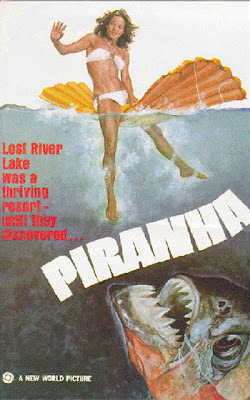
I wonder if you're familiar with Joe Dante's 1978 movie Piranha. In the opening scene a couple of young hikers are lost, walking at night in the mountains, and they discover a mysterious military test site that isn't on their map. So naturally it's a case of "Let's go inside and check it out." They climb over a fence, look around, and immediately find a swimming pool, "Hey far out. Let's get wet. Last one in is a rotten egg." Yep, the girl really says that. They strip off, and in they go. "Hey that's not funny," says the boy. "You bit me. You actually bit me." But no the girl didn't bite him of course, it was a piranha, and before long both young hikers have been devoured by our fishy friends.
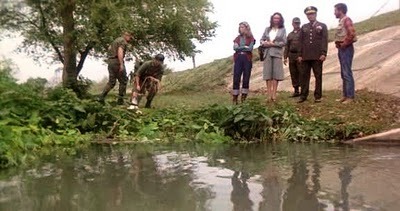
Well, a lesson learned there, I'd say. Since seeing that movie I've never climbed into a mysterious military test site at night, and I've certainly never plunged into a pool without first checking for piranhas. In fact I can't remember ever finding a swimming pool full of water while out walking, though I have encountered a few empty ones.
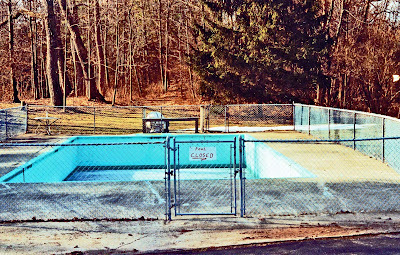
A few years back I came across the one above, in upstate New York, somewhere near Kingston. In fact the pool isn't absolutely, completely empty: a certain amount of slimy rainwater had collected in the bottom, but even without a "pool closed" sign, and even without a fear of piranhas I don't imagine many hikers were stripping off and leaping in.

Desert swimming pools, such as the one below, encountered while I was walking around the Salton Sea, are far more inviting, though completely dry, and quite a few people had obviously been there before me, though to express themselves via graffiti rather than swimming, it seemed. I expect they did some skateboarding there too.
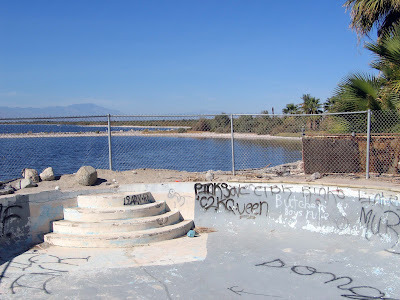
For one reason or another I've been rereading John Cheever's short story "The Swimmer." Of course it's a story about swimming rather than walking, but as the hero, Neddy Merrill, swims his way home via a line of swimming pools, he inevitably does a certain amount of walking, at one point crossing a major highway. "Had you gone for a Sunday afternoon ride that day you might have seen him, close to naked, standing on the shoulders of Route 424, waiting for a chance to cross … An old man tooling down the highway at fifteen miles an hour let him get to the middle of the road where there was a grass divider. Here he was exposed to the ridicule of the northbound traffic, but after ten or fifteen minutes he was able to cross."

I think "The Swimmer" is as perfect as any short story ever gets. Nothing similar can be said about the movie version starring Bert Lancaster. One of the worst scenes, not in the story, but invented for the movie, has Neddy encounter a small boy who's tending an empty pool. The boy's parents are away and the pool has been drained for his safety: he confesses he's not much of a swimmer. The lack of water threatens Neddy's project but he and the boy mime a swim while walking across the bottom of pool. It's the first time the boy has managed to "swim" a length, and initially he's delighted, but then he has his doubts. He says, "I suppose it doesn't count though because there's no water."
"But for us there was," Neddy insists. "You see, if you make believe hard that something is true, then it is true for you."

Well, this is rubbish, isn't it? A lad who can't tell the difference between walking and swimming is obviously going to find himself in serious trouble before very long. "Oh, right, I'll just swim along Hollywood Boulevard. It will be true for me."

But the fact is, there is something strangely enjoyable about walking across the bottom of an empty swimming pool. I think it's that sense of walking in a place that's usually not available to walkers; not walking on water, but walking under water, walking where the water usually makes walking impossible.
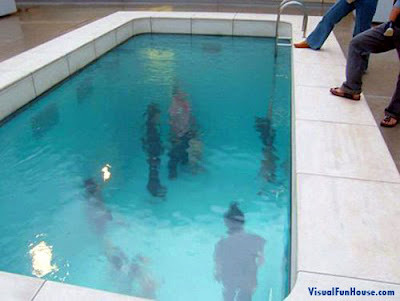
As everybody now knows (I mean, it was a plotline on Seinfield for Pete's sake) Cheever's sexuality was a troublesome matter both to himself and to the people around him. He liked men, but it seems he didn't actively hate women. His story "Goodbye, My Brother" concerns both the agonies of sticking to convenient illusions, and the equal agonies of truth-telling, and it has a wonderfully ambiguous final paragraph that concerns walking and water and much else besides. The final words: "The sea that morning was iridescent and dark. My wife and my sister were swimming -- Diana and Helen -- and I saw their uncovered heads, black and gold in the dark water. I saw them come out and I saw that they were naked, unshy, beautiful and full of grace, and I watched the naked women walk out of the sea."

Published on March 26, 2012 13:48
March 14, 2012
WALKING IN THE FUTURE
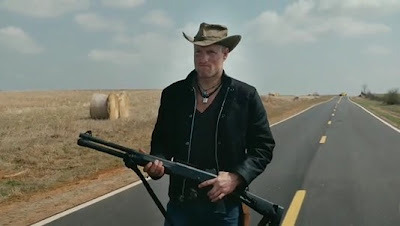
If the movies have taught us anything, it's that in a post-apocalyptic future there will be a lot of walking. Admittedly, there will be a certain amount of driving around in very cool vehicles, but mostly it'll be striding along, gun in hand, ready to kill or be killed. And it seems that very few of us will be dressed appropriately.
There will, of course, be a lot of desert in this future. If you're going to make a post-apocalyptic movie, the desert is often the location of choice. It's pre-ruined in a way that, say, the Palace of Versailles isn't. And you've got to imagine it'll be pretty hot in this desert of the future, but that won't stop a lot of people from wearing a lot of leather.
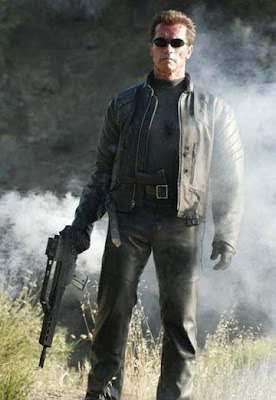
You might argue that a Terminator can get away with it because he's a cyborg and doesn't feel the heat in the same way that real humans feel.
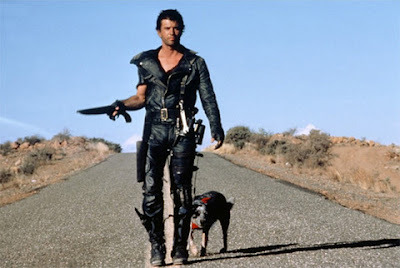
On the other hand, Mad Max is clearly feeling it in this picture, though you have to wonder if simply pulling one arm off your leather suit is really going to be enough to cool you down much.

If you're Linda Hamilton you'll wear an elegant little tank top, showing off your gym-toned arms, but this simply creates a different problem: she's running a terrible risk of sunburn. And if you reckon that in general women of the future will wear be wearing less than the men, you're probably right.
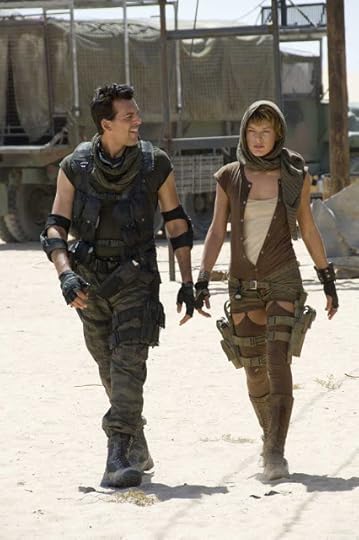
Milla Jovovich certainly looks well wrapped up in some respects in Resident Evil: Extinction but not so much that she can't show her stocking tops and thighs.
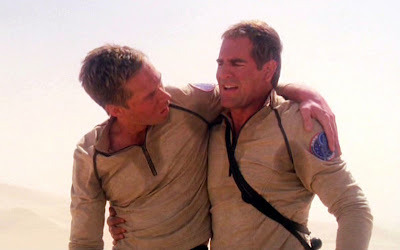
I'm not sure exactly what these boys from Star Trek are wearing in the episode "Desert Crossing." It's not leather obviously: could it be polyester? Clearly they're sweating like SOBs. Later in the episode they do strip down, though they don't actually look much less sweaty or any more comfortable as a result.

And do spare a thought for poor Kyle MacLachlan in Dune. Well yes, there are reasons to feel sorry all for the actors in that movie, but in the picture below it looks as though his sweat problem is so bad that nobody will come anywhere near him. Wouldn't he be much happier in a simple safari suit?
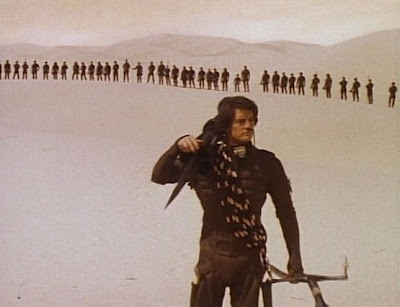
Finally (and I know you could go on about this stuff forever) we come to the movie of The Road. Now that is one bleak future you've got yourself there, but it's not the desert. Instead, it's a cold, grey, polluted world where the sun never shines, and walking is a grim and potentially lethal business. But say what you like, father and son are certainly dressed for it.
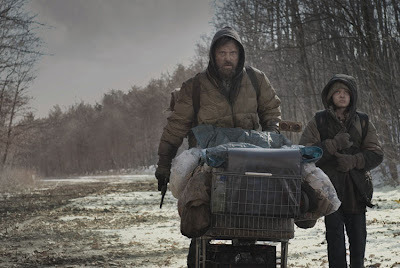

Published on March 14, 2012 15:57
March 8, 2012
WALKING IN RUINS

I've been looking at photographs of people walking in ruins. The one above is one of the most familiar, taken in the London blitz, a morning after shot. And if you'd asked me a couple of days back I'd have said it was by Cecil Beaton or Bill Brandt. It turns out I was wrong about that, as you'll see.
Without really thinking about it too much, I'd always assumed it was a bit of a set up, though not a particularly reprehensible one, a morale-boosting image to show Londoners that life was still going on normally even after a night of bombings. For one thing, I didn't really believe that milkmen were still sticking to their rounds in the middle of the blitz. Would there even be any doorsteps to leave the milk on? And when the milkman came back at the end of the week what were the chances of the customers still being there, what possible likelihood that they'd hand over what they owed?
But it turns out the photograph is even more fake than I thought. The photographer was actually Fred Morley, and it's widely reported that the "milkman" was his assistant dressed up for the part. But that doesn't really solve anything? Because obviously he must have borrowed the coat and the crate of milk from somebody, and if not from a milkman, then who? So does that mean there really were milkmen making deliveries? And if so, why not use a real milkman in the photograph? Couldn't they find one winsome or perky enough? Or did the real milkmen think this photography lark was an insult, but if so they wouldn't have lent their jacket and milk would they? Or were there no real milkmen involved at all, and did the photographer bring the jacket and milk with him as a props? I should really like to know.
It's generally assumed that the firemen working in the background are the genuine article, and I imagine they were extremely pissed off that this photographer and his assistant were free to ponce around taking pictures, while they had real work to do they know there's a war on?
When I was growing up in Sheffield in the 1950s and 60s memories of Sheffield's own blitz were still fresh in the minds of my parents' generation. It had been short-lived and limited by London standards – just two raids in December 1940 - but bad enough; almost 700 dead, another 1500 injured, tens of thousands left homeless.
There was a story told in our family that my father, then in his teens, had walked to work the morning after the bombings, stepping over debris and, according to my mother, also over dead bodies. My father never mentioned it at all, which I've always thought gives the story more rather than less credibility.
There are a lot of extant pictures of the Sheffield blitz, though there seem to be no Sheffield war photographers known by name, no Brandt or Beaton, not even a Fred Morley. The vast majority of the photographs, like the one below, are simply credited to "Sheffield Newspapers."
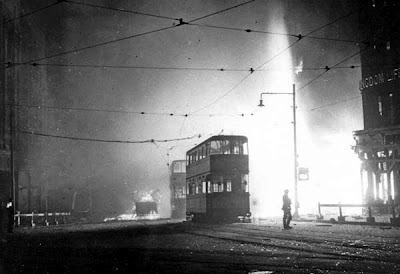
This is the best known, and probably the best, photograph from the Sheffield blitz. It shows the High Street on fire, a couple of abandoned trams silhouetted against the conflagration. Other photographs exist of the scene, taken that night and the next morning, but none look as good as this.
And the fact is, for a photograph of ruins to look really good it really helps to have a figure in it, preferably someone walking, and now I find myself wondering about that solitary figure on the right of the picture. What's he doing there? He looks so untroubled. Where could he possibly be walking to so casually? And I wonder if he was placed there by the photographer for the sake of the shot. I wonder if he was the photographer's assistant. In a post-war article titled "Pictures by Night" Bill Brandt wrote, "In 1939, at the beginning of the war, I was back in London photographing the blackout. The darkened town, lit only by moonlight, looked more beautiful than before or since. I t was fascinating to walk through the deserted streets and photograph houses which I knew well, and which no longer looked three-dimensional, but flat like painted stage scenery ..." And, of course, Brandt was enough of a genius that he could do without including a walking figure.
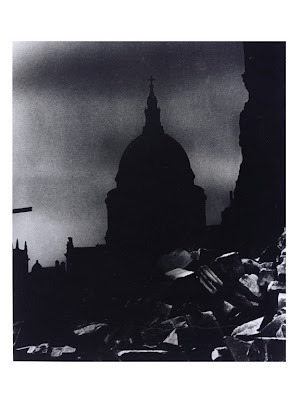

Published on March 08, 2012 18:05
February 28, 2012
WALKING WITH WELLS
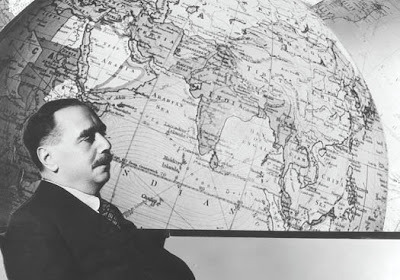
You'll find H.G. Wells quoted all over the internet, both on actual quotation websites, and on those dubious "advice to entry-level writers" sites as having said or written, "I write as straight as I can, just as I walk as straight as I can, because that is the best way to get there."
It comes from An Experiment in Autobiography though none of the online sources I've seen acknowledges this, and he's saying it in order to bad-mouth the prose style of Joseph Conrad, whom he finds a bit fancy and literary. The quotation in full is "I write as I walk because I want to get somewhere and I write as straight as I can, just as I walk as straight as I can, because that is the best way to get there."
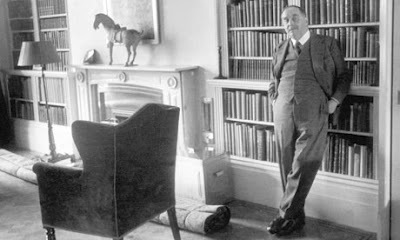
To which the obvious response is surely: well that all depends, doesn't it? Sure, a straight line is the shortest distance between two points, but if the two points are, say, either side of a river, it might be wise to walk along the riverbank to a bridge rather than just plunging straight through the water. There's also the matter that one doesn't need to be some fancypants flaneur to believe that walking isn't always about getting somewhere quickly and efficiently. A walk without an obvious goal is sometimes much more enjoyable that going in a straight line from one place to another.
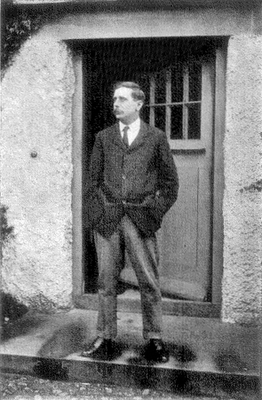
I'm not even all that persuaded by "straightness" as an absolute virtue in writing, but obviously if you're going to write about time travel, improbable experiments in vivisection, and a war of the worlds, then a good plain prose style helps a lot with credibility and suspension of disbelief.
In fact there's some evidence that Wells didn't always walk quite as purposefully as he claims. In the last decade of the nineteenth century he was living in Woking, Surrey with his second wife. His mornings were spent walking, or sometimes cycling, in the nearby countryside: in the afternoons he wrote. Legend has it that he was walking with his brother on one of these mornings, and they imagined how it would be if Martians suddenly landed on this rural English scene and set about destroying it. Thus was born The War of The Worlds, a fine book of walking and ruin.
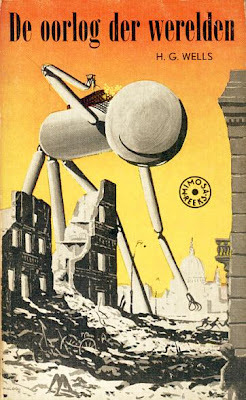
One of the oddest details in the books tells us that the narrator was "much occupied in learning to ride the bicycle" as well as being "busy upon a series of papers discussing the probable developments of moral ideas as civilization progressed." Well yes, that sounds a full life, doesn't it, but he still finds time to go walking with his wife "One night … I went for a walk with my wife. It was starlight and I explained the Signs of the Zodiac to her." No word on whether she thanked him for this.
Anyway, soon enough the Martians arrive, in cylinders, and it takes a while before anything emerges, but then, "And this Thing I saw! How can I describe it? A monstrous tripod, higher than many houses, striding over the young pine trees, and smashing them aside in its career; a walking engine of glittering metal, striding now across the heather." Fortunately a member of the English working class is nearby to offer the description, "Boilers on stilts, I tell you, striding along like men."

Well, you probably already know that things don't go terribly well for mankind. The Martians take over. Finding himself stranded in the colonized Martian zone, our unnamed hero spends a lot of time dodging the tripods, holing up in a ruined house, doing an occasional bit of swimming, and a lot of walking through a devastated and depopulated London and its suburbs. "Scrambling over a ruined wall, (I) went on my way through scarlet and crimson trees towards Kew--it was like walking through an avenue of gigantic blood drops." That strikes me as pretty good, and not entirely unfancy or unliterary.
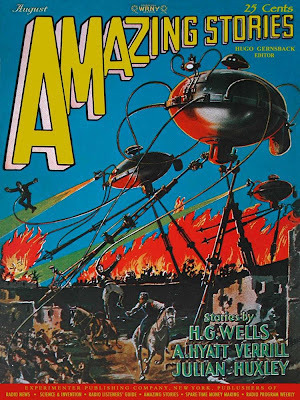
The novel contains a lot of great adventure story stuff and Wells is obviously really on to something with the "aliens in the neighborhood" idea. It's all very well for spacemen to battle monsters on distant planets but there's something far more urgent (and fun) in imagining aliens attacking the local supermarket. And who hasn't fantasized about walking through a familiar but ruined world in which you're the only survivor?
Still, it all turns out all right thanks to our friends the bacteria, the Martians die, civilization returns, and one of the last images in the books has our hero standing on Primrose Hill, where he's able "to see the people walking to and fro among the flower beds on the hill, to see the sight-seers about the Martian machine that stands there still." Being able to walk freely about the city is an emblem both of freedom and order.
Visitors to modern day Woking city center can do something just a little similar, and walk around a 23 foot high sculpture by Michael Condron of one of the Martian tripods. Gotta say I'm just a little disappointed that it doesn't have feet.
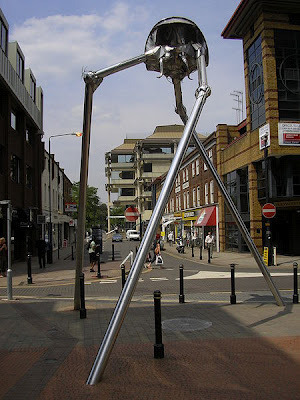
It's always hard to imagine how exactly a tripod walks – does it move just one leg at a time, which seems rather slow and laborious, or does it move one leg and use that as a pivot as it brings the other two forward, which seems like it would cause a lot of instability.
http://drzeus.best.vwh.net/wotw/
Above is a link to a wonderful website, from which I've borrowed some of the images in this post, that shows multiple covers for different editions of The War of the World, and it's interesting how few of the illustrators address the question of how the tripods walk. Quite a few of those tripods on the covers would be hard pressed to get around at all, while some of them seem to be floating rather than walking. And a certain of the illustrators have evidently not read the book at all.
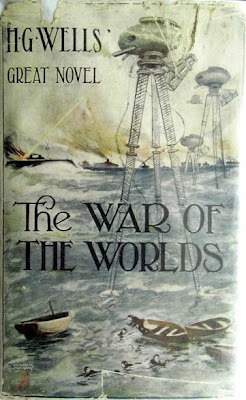
Above is one of my favorites, a 1916 Heinemann edition (it comes courtesy of Andrew Cox) which is true to the spirit of the book, but also seems to be anticipating steampunk. To me, it also looks like it might have been an inspiration for Guy Maunsell, the designer of the Maunsell Sea Forts, a World War Two defense system in the Thames estuary, and briefly home to a pirate radio station.
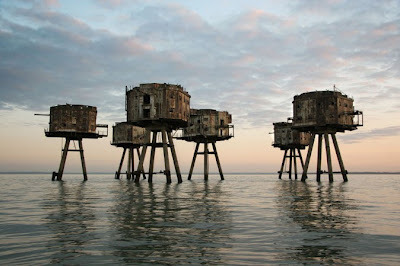
I find it very easy to imagine those sea forts uprooting themselves from the seabed and walking into London to destroy humanity. I do realize that they're quadrupeds rather than tripods, but surely that would make the walking and the destruction very much easier.
And finally an image that gives me so much pleasure. If the Martians had really attacked, and if Sherlock Holmes had been a real person, then he'd certainly have been around for it. And if you're going to show Britain in ruins, why not show Britain's most famous ruin, Stonehenge?


Published on February 28, 2012 17:32
Geoff Nicholson's Blog
- Geoff Nicholson's profile
- 55 followers
Geoff Nicholson isn't a Goodreads Author
(yet),
but they
do have a blog,
so here are some recent posts imported from
their feed.























